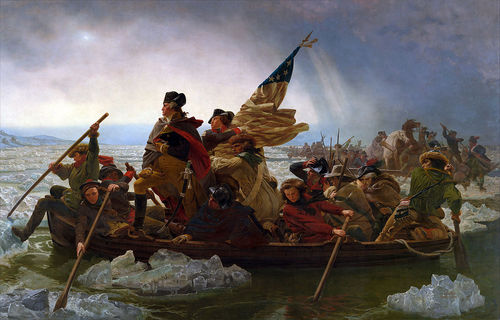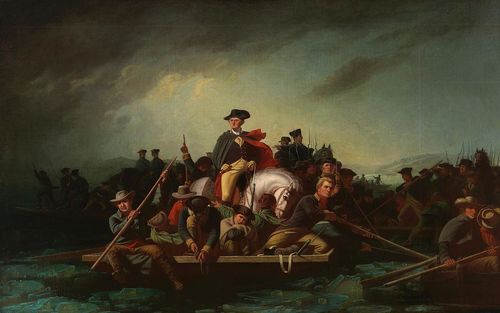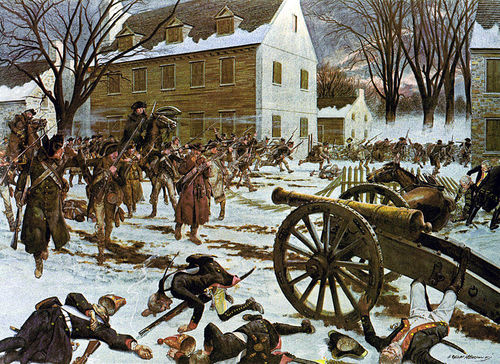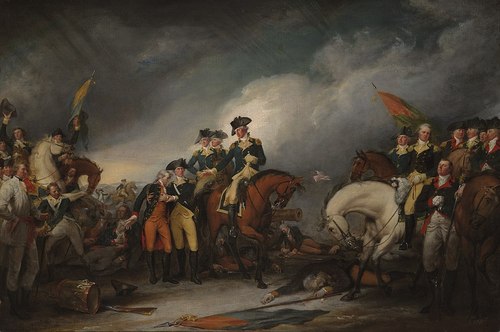Washington's Crossing of the Delaware River
Welcome to the BIRD Chronicles
Washington's Crossing of the Delaware River
Battle of Trenton
Colonel Mark BIRD (1739-1812)
Washington Crossing the Delaware, oil painting by Emmanuel Leutze in 1851 in the Metropolitan Museum of Art

Washington's Crossing of the Delaware River
Battle of Trenton
Colonel Mark BIRD (1739-1812)
Terry Louis Linton © 1986
LINTON & BIRD Chronicles Volume I, Issue 9 © Linton Group Limited 1986
LINTON & BIRD Chronicles This Day in History © 2009
Linton Research Fund Inc., Publication © 2009
LINTON & BIRD Chronicles, Volume VI, Issue 3, Fall © 2011, ISSN 1941-3521
Updated December 27, 2017
Commander-in-Chief General George WASHINGTON (1732-1799) and his Continental Army in late December 1776 had previously suffered several defeats in New York and had been forced to retreat through New Jersey to Pennsylvania. Morale in the army was low.
General Washington believed that General Sir William HOWE (1729-1814), the Commander-in-Chief of British forces, would launch an attack from the north on Philadelphia if the Delaware River froze over. General Washington stared planning in secrecy an attack on the British forces with launching coordinated attacks from three directions.
On December 14, 1776, the Hessians Army arrived in Trenton, New Jersey under the command of Colonel Carl von DONOP (1732-1777) and established their winter quarters. At the time, Trenton was a small town with about 100 houses and two main streets, King (now Warren) Street and Queen (now Broad) Street. [i] Trenton is now the capital of New Jersey and the county seat of Mercer County. Trenton was briefly the capital of the United States in 1784.
On December 17, 1776, General Washington ordered Colonel Samuel GRIFFIN (1746-1810) to cross the Delaware River with his 600 men and marched to Mount Holly, where he set up a few "3-pounder" artillery pieces on Iron Works Hill.
On December 22, Colonel Carl von DONOP marched south to Mount Holly, Burlington County, New Jersey, leaving Colonel Johann RALL (1729-1776) in command of the garrison in Trenton.
On December 23, Colonel Donop started a three day long artillery exchange, known as the Battle of Iron Works Hill or Battle of Mount Holly. Colonel Griffin and his Virginias slipped away late in the night of the 26th. [ii]
On Christmas Eve, December 24, 1776, General Washington, in Bucks County, Pennsylvania, started his three prong surprise attack on the Hessian forces in Trenton. Security was tightened at the crossing. A final planning meeting took place that day, at McConkey's Ferry Inn, where General Washington and his aides ate dinner and made plans prior to the crossing, with all of the general officers present. General orders were issued by Washington outlining plans for the operation. [iii]
Brigadier General John GLOVER (1732-1797) was placed in command the boats. Glover’s Marblehead 14th Massachusetts Regiment, were experienced watermen. They were joined by other seamen, dockworkers and shipbuilders from Philadelphia, as well as local ferry operators and boatmen who knew the river well. [iv] The watercraft boats were brought down from Malta Island near New Hope. They were hidden behind Taylor Island at McConkey's Ferry, Washington's planned crossing site.
Most of the boats used in the crossing were Durham boats. These boats were designed to carry heavy loads from the Durham Iron Works. They featured high sides and a shallow draft and could be poled across the river. [v] These Durham boats were supplied by Colonel George TAYLOR (1716–1781), commander of the Third Battalion of the Pennsylvania Militia, from his Durham Iron Works. Colonel Taylor was the ironmaster of Durham Iron Works located in Durham Township, Bucks County, Pennsylvania and a signer of the Declaration of Independence as a representative of Pennsylvania Colony. [vi] Ironmaster, Colonel Mark BIRD (1739-1812), now the Deputy Quarter Master General of the Continental Army, [vii] was a close friend and long time business associate of ironmaster George Taylor. Their partnership began in 1751 with the leasing of Durham Iron Works and again in 1774. On August 2, 1775, Taylor secured a contract with Pennsylvania’s Committee of Safety for cannon shot. [viii] On August 25, 175, with a shipment of 258 round balls weighing from 18 to 32 pounds each, from Durham Furnace became the first ironworks in Pennsylvania to supply munitions to the Continental Army. [ix] These two ironmasters had numerous business deals during and after the war ended.
“Washington Crossing the Delaware” by George Caleb Bingham in 1856 (public domain) depicting Washington in a Durham boat.
General Washington gave charge of the crossing logistics to his chief of artillery, Major General Henry KNOX (1750-1806). In addition to the crossing of large numbers of troops (most of whom could not swim), he had to safely transport horses and eighteen pieces of artillery over the river. Knox wrote that the crossing was accomplished "with almost infinite difficulty", and that its most significant danger was "floating ice in the river".One observer noted that the whole operation might well have failed "but for the stentorian lungs of Colonel Knox". [x]
The crossings proved dangerous in the severe weather, two columns could not join Washington’s column leaving him 3,000 less than planned. Lieutenant Colonel John CADWALADER (1742-1786), crossing at the Dunk's Ferry, between Bristol and Burlington, successfully crossing his light forces, but the river ice prevented crossing his artillery. Lieutenant Colonel Cadwalader then returned his column to the Pennsylvania side. [xi] Brigadier General James EWING (1736-1806) column, positioned directly across from Trenton, was unable to cross the river. Washington later wrote "the Quantity of Ice was so great, that tho' he did every thing in his power to effect it, he could not get over." [xii]
At four in the morning Commander-in-Chief General Washington led his column of 3,231 Continental Army troops across the icy Delaware River. Major General Nathanael GREENE (1742-1786) Division of 2,690 men and Brigadier General Adam STEPHEN (1718-1791) Brigade with 541 men. [xiii] The column marched 9 miles to Trenton. Many of the troops did not have boots, so they were forced to wear rags around their feet. Some of the men's feet bled, turning the snow to a dark red. Two men died on the march. [xiv] General Sullivan sent a courier to telling Washington that the “weather was wetting his men's gunpowder” Washington responded, "Tell General Sullivan to use the bayonet. I am resolved to take Trenton. " [xv] Washington led the main body of the Continental Army and kept riding down the lines of soldiers encouraging his men that they could take Trenton and still make it back to their families alive. They surprised and defeated the Hessian troops of Colonel Johann RALL (1729-1776), quartered in Trenton, at the Battle of Trenton.
“Battle of Trenton” by H. Charles McBarron, Jr., © 1975
Colonel RALL was mortally wounded, shot twice in the side and carried back to his headquarters, where he died that night. Nearly the entire Hessian force was captured, with negligible losses to the Americans. “The battle significantly boosted the Continental Army's flagging morale, and inspired re-enlistments.” The Battle was George Washington's first military victory of the Revolutionary War.
“Capture of the Hessians” at Trenton, on December 26, 1776, by John Trumbull, depicting General George Washington and Colonel Johann Rall.
The Continental Army re-crossed the Delaware River back into Pennsylvania, this time burdened by prisoners and military stores taken as a result of the battle. [xvi] Quarter Master General, Major General Thomas MIFFLIN (1744-1800) aide to General Washington ordered Colonel Stephen MOYLAN (1737–1811) and Colonel Mark BIRD (1739-1812) both Deputy Quarter Master Generals to “undertake this task”. [xvii]
All most two years before, On April 30, 1775, Ironmaster Mark BIRD (1739-1812) was elected the Lieutenant Colonel of the Second Battalion of the Berks County Militia. He provided uniforms, tents and provisions for 300 militia men, who were recruited in the vicinity of his iron works at Hopewell and Birdsboro. He was promoted to Colonel when the battalion was made part of the Continental Army and served as commander until the end of December 1776. [xviii]
On December 27, 1776, General George Washington ordered Colonel Mark BIR (1739-1812) to take charge of the captured Hessian forces taken at the Battle of Trenton. The captured Hessians were marched to Philadelphia and paraded through the streets of Philadelphia to raise American morale. The anger at their presence helped the Continental Army recruit new soldiers. [xix] Later, most of the prisoners were sent to work as farm hands. Colonel Bird sent some to his Hopewell and Birdsboro ironworks as indenture servants in Berks County. Pennsylvania. [xx] Some of the Hessians were sent to Lancaster County, Pennsylvania and in 1777 the remaining were moved to Virginia. [xxi] The Second Continental Congress authorized the offer of 50 acres of land to individual Hessian soldiers to encourage them to desert and the British soldiers were offered 50 to 800 acres, depending on rank. [xxii]
On January 6, 1777, after two significant victories over the British in Trenton and Princeton, New Jersey, General Washington marched his Continental Army to Morristown, New Jersey, where he set up winter headquarters.
________________________________________________________
Linton Research Fund Inc., Publication © 1987-2024 “Digging for our roots”

Sources:
[i] Ketchum, Richard (1999). The Winter Soldiers: The Battles for Trenton and Princeton (1st Owl books ed.). Holt Paperbacks. ISBN 0-8050-6098-7.
[ii] History, Battle of Iron Works Hill. December 23, 1776.
[iii] Ketchum, Richard (1999). The Winter Soldiers: The Battles for Trenton and Princeton. Owl Books. ISBN 0-8050-6098-7.
[iv] David Hackett Fischer, (2006) Washington's Crossing. Oxford University Press, 2004. ISBN 0-19-517034-2.
[v] Fischer, David Hackett (2006). Washington's Crossing. Oxford University Press. ISBN 0-19-517034-2.
[vi] Ely, Warren S. (1926). "George Taylor, Signer of the Declaration of Independence". A Collection of Papers Read Before the Bucks County Historical Society. Meadville, Pennsylvania: Bucks County Historical Society. V: 100–12.
[vii] Pennsylvania, Revolutionary War Battalions and Militia Index, 1775-1783 Vol. 2 page 260
[viii] Ely, Warren S. (1926). "George Taylor, Signer of the Declaration of Independence". A Collection of Papers Read Before the Bucks County Historical Society. Meadville, Pennsylvania: Bucks County Historical Society. V: 100–12.
[ix] Fackenthal, Benjamin Franklin (1926). "The Homes of George Taylor". A Collection of Papers Read Before the Bucks County Historical Society. Meadville, Pennsylvania: Bucks County Historical Society. V: 112–33.
[x] Fischer, David Hackett (2006). Washington's Crossing. Oxford University Press. ISBN 0-19-517034-2. Page 218
[xi] Fischer, David Hackett (2006). Washington's Crossing. Oxford University Press. ISBN 0-19-517034-2.
[xii] George Washington Papers Series 6, Military Papers, 1755-1798
[xiii] Fischer, David Hackett (2004). Order of battle of the Battle of Trenton Washington's Crossing. New York: Oxford University Press. ISBN 0-19-518159-X.
[xiv] Scheer, George (1987). Rebels and Redcoats. Da Capo Press. ISBN 0-306-80307-0.
[xv] Kevin Wright. "The Crossing And Battle At Trenton – 1776". Bergen County Historical Society.
[xvi] Wood, W.J. Henry Battles of the Revolutionary War. Da Capo Press. ISBN 0-306-81329-7.
[xvii] George Washington Papers Series 6, Military Papers, 1755-1798
[xviii] Linton, Terry L. Colonel Marcus “Mark” BIRD (1739-1812), Revolutionary War Patriot (Birdsboro 250th Anniversary Bird Family History Speaker, 1990)
[xix] Johannes Schwalm the Hessian, p. 21]
[xx] Rodney Atwood The Hessians. Cambridge University Press. p. 199.
[xxi] Fischer, David Hackett (2006). Washington's Crossing. Oxford University Press. ISBN 0-19-517034-2.
[xxii] R. Douglas Hurt (2002) American Agriculture: A Brief History, p. 80
________________________________________________________________________________
“We exist because of our ancestors, let’s try not to forget them”

Main Menu
Linton Research Fund, Inc., HOME PAGE
LINTON Chronicles Table of Contexts
LINTON Ancestors in the Revolutionary
LINTON Ancestors in the Civil War 1861-1865
BIRD Chronicles Table of Contents
Bird Ancestors in the Revolutionary War
BIRD Ancestors in the Civil War 1861-1865
Today's Birthdays & Anniversaries
History of the Linton Research Fund Inc., LINTON & BIRD Chronicles
LINTON & BIRD Chronicles on Facebook
![]() "Thanks for Visiting, come back when you can stay longer" Terry Louis Linton © 2007
"Thanks for Visiting, come back when you can stay longer" Terry Louis Linton © 2007
Linton Research Fund Inc., Publication © 1987-2024 “Digging for our roots”
LINTON & BIRD Chronicles
Established 1984
Quarterly Publication of the Linton Research Fund Inc. ![]()



